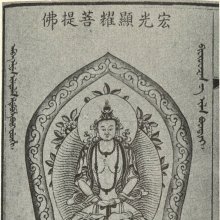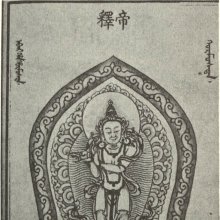Yana, Yāna: 31 definitions
Introduction:
Yana means something in Buddhism, Pali, Hinduism, Sanskrit, Marathi, Jainism, Prakrit, Hindi, biology. If you want to know the exact meaning, history, etymology or English translation of this term then check out the descriptions on this page. Add your comment or reference to a book if you want to contribute to this summary article.
Alternative spellings of this word include Yaan.
Images (photo gallery)
(+180 more images available)
In Hinduism
Dharmashastra (religious law)
Source: Wisdom Library: Dharma-śāstraYāna (यान) refers to “marching” (towards a king). Yāna is considered to be one of the six constituents of state-craft that the King shall constantly ponder over. The word is used throughout Dharmaśāstra literature such as the Manusmṛti. (See the Nītiprakāśikā 8.82 and the Manubhāṣya 7.160)
Yāna (यान) refers to the “chariot” and the rest. (See the Manubhāṣya, verse 8.290)
Source: Google Books: Manusmṛti with the ManubhāṣyaYāna is marching for the furtherance of one’s own interests and the destruction of the enemy’s. (See the Manubhāṣya verse 7.160 et. seq.)
Marching is of two kinds—
- singly,
- and conjointly with an ally.

Dharmashastra (धर्मशास्त्र, dharmaśāstra) contains the instructions (shastra) regarding religious conduct of livelihood (dharma), ceremonies, jurisprudence (study of law) and more. It is categorized as smriti, an important and authoritative selection of books dealing with the Hindu lifestyle.
Purana and Itihasa (epic history)
Source: archive.org: Puranic EncyclopediaYāna (यान).—One of the royal qualities like Sandhi, Vigraha etc. (For more details see under Ṣaḍguṇas).
Source: Cologne Digital Sanskrit Dictionaries: The Purana IndexYāna (यान).—A Sādhya god.*
- * Vāyu-purāṇa 66. 15.
Yāna (यान) refers to one of the various kinds of articles used for donation, according to the 10th century Saurapurāṇa: one of the various Upapurāṇas depicting Śaivism.—Accordingly, the tenth chapter contains the praise and classification of donations. It narrates the characteristics of proper recipients and the results of giving different kinds of articles like Bhūmi, Vidyā, Anna, Jala, Tila, Vāsa, Dīpa, Yāna, Śayyā, Dhānya, Aśva, Śāka, Indhana, Chatra, Auṣadha, Go, etc.

The Purana (पुराण, purāṇas) refers to Sanskrit literature preserving ancient India’s vast cultural history, including historical legends, religious ceremonies, various arts and sciences. The eighteen mahapuranas total over 400,000 shlokas (metrical couplets) and date to at least several centuries BCE.
Jyotisha (astronomy and astrology)
Source: Wisdom Library: Brihat Samhita by VarahamihiraYāna (यान) refers to “vehicles”, according to the Bṛhatsaṃhitā (chapter 15) (“On the nakṣatras—‘asterisms’”), an encyclopedic Sanskrit work written by Varāhamihira mainly focusing on the science of ancient Indian astronomy astronomy (Jyotiṣa).—Accordingly, “Those who are born on the lunar day of Anurādhā will be valiant; heads of parties; fond of the company of Sādhus, keep vehicles [i.e., yāna] and grow every species of crop. Those who are born on the lunar day of Jyeṣṭhā will be valiant, of good descent, wealthy, famous; disposed to cheat others of their property, fond of travelling, rulers of provinces or commanders of armies. [...]”.

Jyotisha (ज्योतिष, jyotiṣa or jyotish) refers to ‘astronomy’ or “Vedic astrology” and represents the fifth of the six Vedangas (additional sciences to be studied along with the Vedas). Jyotisha concerns itself with the study and prediction of the movements of celestial bodies, in order to calculate the auspicious time for rituals and ceremonies.
Shaivism (Shaiva philosophy)
Source: SOAS University of London: Protective Rites in the Netra TantraYāna (यान) refers to a “vehicle”, according to the Svacchanda-tantra.—Accordingly, [verse 4.3-6, while describing the interpretation of dreams]—“In [auspicious] dreams [the dreamer] drinks wine, eats raw flesh, smears insect feces and sprinkles blood. He eats food of sour milk and smears a white garment. [He holds] a white umbrella over his head, decorates [himself] with a white garland or ribbon. [He sees] a throne, chariot or vehicle (yāna), the flag of royal initiation. He decorates [these things] with a coral, betel leaf fruit. [He also] sees Śrī or Sarasvatī”.

Shaiva (शैव, śaiva) or Shaivism (śaivism) represents a tradition of Hinduism worshiping Shiva as the supreme being. Closely related to Shaktism, Shaiva literature includes a range of scriptures, including Tantras, while the root of this tradition may be traced back to the ancient Vedas.
Yoga (school of philosophy)
Source: ORA: Amanaska (king of all yogas): A Critical Edition and Annotated Translation by Jason BirchYāna (यान) refers to “vehicle (of the breath)”, according to the Amanaska Yoga treatise dealing with meditation, absorption, yogic powers and liberation.—Accordingly, as Īśvara says to Vāmadeva: “[...] [The Yogin], whose foot-soldiers are his quietened senses and who is endowed with [a successful king’s] powers [in the form of] his higher faculty of discernment, becomes joyful when he has conquered the hostile mind-king who is accompanied by his [royal] vehicle, the breath (vāyu-yāna-yuta). [...]”.

Yoga is originally considered a branch of Hindu philosophy (astika), but both ancient and modern Yoga combine the physical, mental and spiritual. Yoga teaches various physical techniques also known as āsanas (postures), used for various purposes (eg., meditation, contemplation, relaxation).
In Buddhism
Mahayana (major branch of Buddhism)
Source: Wisdom Library: Maha Prajnaparamita SastraYāna (यान) refers to “vehicles” and is mentioned among the “material benefits” granted by the Bodhisattva, according to the Mahāprajñāpāramitāśāstra chapter XLVI.—Accordingly, “vehicles (yāna), i.e., elephants (hastin), horses (aśva), chariots (ratha), carriages (śakaṭa), etc.”
Source: academia.edu: A Study and Translation of the Gaganagañjaparipṛcchā1) Yāna (यान) refers to the “religious way”, according to the Gaganagañjaparipṛcchā: the eighth chapter of the Mahāsaṃnipāta (a collection of Mahāyāna Buddhist Sūtras).—Accordingly, “Then, in order to clarify this point further, the Lord went on to speak these verses: ‘(54) Homage (satkāra) should be beyond attachment and ill-will, it should not discriminate between superior, inferior. The religious way (yāna) which is just like the ground and threshold (indrakīla), teaches patience in order to purify living beings”.
2) Yāna (यान) refers to “(the three) vehicles”, according to the Gaganagañjaparipṛcchā.—Accordingly: “[...] As long as the Buddhas and Bodhisatvas in ten directions taught a hundred thousand ways into the dharma (dharmamukha) by means of syllables, explanations, and agreed terms, all those voices of the dharma, which never increase or decrease and do not enter into any difference, resonated in the open space endlessly. By the sound of the dharma, all living beings in this world system of three thousandfold worlds obtained this understanding, and thus immeasurable and incalculable living beings became matured in the three vehicles (tri-yāna). [...]”

Mahayana (महायान, mahāyāna) is a major branch of Buddhism focusing on the path of a Bodhisattva (spiritual aspirants/ enlightened beings). Extant literature is vast and primarely composed in the Sanskrit language. There are many sūtras of which some of the earliest are the various Prajñāpāramitā sūtras.
General definition (in Buddhism)
Source: archive.org: The Indian Buddhist Iconography (b)Yāna (यान) refers to the different paths or divisions of Buddhism.—Lord Buddha prescribed Yānas in the beginning, namely, the Śrāvakayāna and the Pratyekabuddhayāna. [...] Buddhism continued in this state till the rise of the Mahāyāna properly called, the Bodhisattvayāna. [...] Thus there were three Yānas in Buddhism about 300 A.D. which may approximately be taken as the time of Asaṅga. But against these three Yānas there were four schools of philosophy in Buddhism, namely, the Sarvāstivāda (Sautrāntika), the Vāhyārthabhaṅga (Vaibhāṣika), the Vijñānavāda (Yogācāra), and the Śūnyavāda (Madhyamaka). How these four systems of philosophy were distributed amongst the three Yānas is one of the vital questions of Buddhism.
Source: Buddhist Door: Glossarya Sanskrit word means vehicle. A term applied to Buddhism as a means by which a practitioner cultivates on the path to enlightenment. The different vehicles correspond to views of spiritual path, that differ as to the basic attitude of the practitioner and the means of making progress on the way. There are categories of one, two, three and five vehicles.Biology (plants and animals)
Source: Google Books: CRC World Dictionary (Regional names)1) Yana in India is the name of a plant defined with Ficus racemosa in various botanical sources. This page contains potential references in Ayurveda, modern medicine, and other folk traditions or local practices It has the synonym Covellia glomerata Miq. (among others).
2) Yana in Latin America is also identified with Ximenia americana It has the synonym Heymassoli spinosa Aubl. (etc.).
3) Yana in South America is also identified with Nicotiana tabacum It has the synonym Nicotiana tabaca St.-Lag. (etc.).
Example references for further research on medicinal uses or toxicity (see latin names for full list):
· Bulletin of the Torrey Botanical Club (1946)
· American Journal of Botany (1989)
· Journal of Ethnopharmacology (1984)
· Boletim da Sociedade Broteriana (1981)
· Species Plantarum (1762)
· Histoire des plantes de la Guiane Françoise (1735)
If you are looking for specific details regarding Yana, for example health benefits, chemical composition, extract dosage, pregnancy safety, side effects, diet and recipes, have a look at these references.

This sections includes definitions from the five kingdoms of living things: Animals, Plants, Fungi, Protists and Monera. It will include both the official binomial nomenclature (scientific names usually in Latin) as well as regional spellings and variants.
Languages of India and abroad
Pali-English dictionary
Source: BuddhaSasana: Concise Pali-English Dictionaryyāna : (nt.) a carriage; vehicle; going.
Source: Sutta: The Pali Text Society's Pali-English DictionaryYāna, (nt.) (fr. yā, as in yāti. Cp. Vedic yāna and Lat. Janus) 1. going, proceeding J. VI, 415 (+ayāna, opposed to ṭhāna).—2. means of motion, carriage, vehicle. Different kinds of carriages are enumerated at Nd1 145 (on Sn. 816) with hatthi° (elephant-), go° (cow-), aja° (goat-), meṇḍaka° (ram-), oṭṭha° (camel-?), khara° (donkey-). Cp. Miln. 276.—yāna is one of the requisites (carriage or other means of locomotion) of the bhikkhu & as such included in the deyya-dhamma or 14 gifts (see yañña & deyya-dh.). Thus mentioned with anna pāna vattha etc. at S. I, 94; A. II, 85; Pug. 51.—Cp. the definition & application of the term yāna as given below under yāna-sannidhi.—See e.g. the foll. passages: Vin. I, 191 (bhikkhū yānena yāyanti ... na bhikkhave yānena yāyitabbaṃ; yo yāyeyya etc. : here a “carriage” is expressly forbidden to the bhikkhu!), 231 (Ambapālī bhadrāni-bhadrāni yānāni yojāpetvā bhadraṃ yānaṃ abhirūhitvā ... ), 242 (same phrase with Meṇḍaka gahapati); D. I, 7, 89, 106; M. I, 366 (yānaṃ poroseyyaṃ pavara-maṇi-kuṇḍalaṃ, where vv. ll. on p. 561 read voropeyya and oropeyya, which Neumann (unwarrantedly) adopts in his translation: Mittl. Sammlung2 1921, II. 666; the C. accepts reading poroseyya with explanation “puris-anucchavikaṃ yānaṃ”); Dh. 323 (=hatthiyānādīni DhA. IV, 6); J. III, 525 sq.; V, 59; VI, 223 (=ratha); Kvu 599 (Erāvaṇo hatthināgo sahassa-yuttaṃ dibbaṃ yānaṃ; translated as “the wondrous elephant E. the thousand-wise yoked celestial mount. ” trsl. p. 347 (lit. vehicle) Pv III, 228 (=ratha or vayha etc. PvA. 186); PvA. 113.—iddhi-yāna carriage of magic power Miln. 276; deva° godly carriage Miln. 276; applied to the 8 fold Aryan Path at Sn. 139 (=devalokaṃ yāpetuṃ samatthatā ... aṭṭha-samāpatti-yānaṃ SnA 184). Similarly of the Path: magg’aṭṭhaṅgika-yāna (—yāyinī) Th. 2, 389 (=aṭṭhaṅgika-magga-saṅkhāta ariya-yāna ThA. 257); and brahma-yāna dhamma-yāna “the very best & excellent carriage” as Ep. of magga S. V, 5, cp. J. IV, 100. Cp. the later terms mahā and hīna-yāna. See also yānikata.

Pali is the language of the Tipiṭaka, which is the sacred canon of Theravāda Buddhism and contains much of the Buddha’s speech. Closeley related to Sanskrit, both languages are used interchangeably between religions.
Marathi-English dictionary
Source: DDSA: The Molesworth Marathi and English Dictionaryyāna (यान).—n (S) Any vehicle or form of conveyance, a carriage, litter, beast, ship. 2 Going, proceeding, traveling.
Source: DDSA: The Aryabhusan school dictionary, Marathi-Englishyāna (यान).—n A vehicle, carriage, ship. Going.
Marathi is an Indo-European language having over 70 million native speakers people in (predominantly) Maharashtra India. Marathi, like many other Indo-Aryan languages, evolved from early forms of Prakrit, which itself is a subset of Sanskrit, one of the most ancient languages of the world.
Sanskrit dictionary
Source: DDSA: The practical Sanskrit-English dictionaryYāna (यान).—[yā bhāve-lyuṭ]
1) Going, moving, walking, riding; as गजयानम्, उष्ट्र°, रथ° (gajayānam, uṣṭra°, ratha°) &c.
2) A voyage, journey; समुद्र- यानकुशलाः (samudra- yānakuśalāḥ) Manusmṛti 8.157; Y.1.84.
3) Marching against, attacking (one of the six Guṇas or expedients in politics); अहितान् प्रत्यभीतस्य रणे यानम् (ahitān pratyabhītasya raṇe yānam) Ak.; Manusmṛti 7.16.
4) A procession, train.
5) A conveyance, vehicle, carriage, chariot; यानं सस्मार कौबेरम् (yānaṃ sasmāra kauberam) R.15.45;13.69; Kumārasambhava 6.76; Manusmṛti 4.12.
6) A litter, palanquin.
7) A ship, vessel.
8) (With Buddhists) The method of arriving at knowledge; the means of release from repeated births; cf. महायान, हीनयान (mahāyāna, hīnayāna).
9) An aeroplane (vimāna); Bhāgavata 4.3.6.
-naḥ Ved. A road, way.
Derivable forms: yānam (यानम्).
Source: Cologne Digital Sanskrit Dictionaries: Edgerton Buddhist Hybrid Sanskrit DictionaryYāna (यान).—nt. (sometimes with m. endings), vehicle, as in Sanskrit and Pali; in Pali also used of the 8-fold Noble Path, as the vehicle to salvation; by extension of this use, in [Buddhist Hybrid Sanskrit] applied to the two vehicles (mahā°, hīna°), or three, with pratyeka(buddha)-yāna between the two; that is, religious methods, within the fold of Buddhism. See Saddharmapuṇḍarīka 75.11, 76.2 ff. (parable of the burning house, the 3 yānas compared to carts of different sizes); for mahā-y° synonyms are buddha-y°, bodhisattva-y°, eka-y° (because, Saddharmapuṇḍarīka 40.13 f. says, this is really the only vehicle, na kiṃcic… dvitīyaṃ vā tṛtīyaṃ vā yānaṃ saṃvidyate); eka-y° also Mahāvyutpatti 1255; agra-yāna, q.v., id.; triyānam ekayānaṃ ca Laṅkāvatāra-sūtra 155.14; the 3 yānas mentioned, but not named, Mahāvastu ii.362.8 f., where it is specifically stated that one can attain parinirvāṇa by any of them, and no preference is expressed; in Saddharmapuṇḍarīka 43.7 (in times of corruption, the Tathā- gatas) upāyakauśalyena tad evaikaṃ buddhayānaṃ triyānanirdeśena nirdiśanti; synonym of hīna-y° is also śrāvaka-y°; see the various terms, also nava-(acira-)- yāna-saṃprasthita.
Source: Cologne Digital Sanskrit Dictionaries: Shabda-Sagara Sanskrit-English DictionaryYāna (यान).—n.
(-naṃ) 1. Any vehicle or form of conveyance, as a carriage, a litter, a horse, an elephant, &c. 2. Going, marching, proceeding. 3. Invading, marching against an enemy. E. yā to go, aff. lyuṭ .
Source: Cologne Digital Sanskrit Dictionaries: Benfey Sanskrit-English DictionaryYāna (यान).—i. e. yā + ana, n. 1. Going, [Mānavadharmaśāstra] 4, 72; moving, [Pañcatantra] iii. [distich] 248. 2. Marching, generally comprising as well: Retreating before an enemy ([Pañcatantra] iii. [distich] 34; cf. 35, and p. 153, 6, 7), as: Attacking an enemy ([Pañcatantra] iii. [distich] 35; [Mānavadharmaśāstra] 7, 160). 3. Any vehicle or form of conveyance, a carriage, [Mānavadharmaśāstra] 2, 202.
Source: Cologne Digital Sanskrit Dictionaries: Cappeller Sanskrit-English DictionaryYāna (यान).—[adjective] leading (of a way) to ([genetive] or [adverb] in trā). [neuter] going, riding, marching; way, course; ship, vehicle i.[grammar], waggon, chariot.
Source: Cologne Digital Sanskrit Dictionaries: Monier-Williams Sanskrit-English Dictionary1) Yāna (यान):—[from yā] a mfn. leading, conducting (said of a road; ‘to’ [genitive case] or [adverb] in trā), [Ṛg-veda]
2) [from yā] n. (ifc. f(ā). ) a journey, travel
3) [v.s. ...] going, moving, riding, marching etc. to ([locative case] or [compound]) or upon ([instrumental case] or [compound]) or against ([accusative] with prati), [Manu-smṛti; Mahābhārata] etc.
4) [v.s. ...] a vehicle of any kind, carriage, waggon, vessel, ship, litter, palanquin, [Ṛg-veda] etc. etc.
5) [v.s. ...] (with Buddhists) the vehicle or method of arriving at knowledge, the means of release from repeated births (there are either 3 systems, the śrāvaka-yāna, the pratyeka-buddha-y or pratyeka-y, and the mahā-y; or more generally only 2, the mahā-yāna or ‘Great method’ and the hina-y or ‘Lesser method’; sometimes there is only ‘One Vehicle’, the eka-yāna, or ‘one way to beatitude’), [Saddharma-puṇḍarīka; Dharmasaṃgraha 2] (cf. [Monier-Williams’ Buddhism 159 etc.])
6) b etc. See p. 849, col. 3.
Source: Cologne Digital Sanskrit Dictionaries: Yates Sanskrit-English DictionaryYāna (यान):—(naṃ) 1. n. Any vehicle or form of conveyance; going; invading.
Source: DDSA: Paia-sadda-mahannavo; a comprehensive Prakrit Hindi dictionary (S)Yāna (यान) in the Sanskrit language is related to the Prakrit word: Jāṇa.
[Sanskrit to German]
Sanskrit, also spelled संस्कृतम् (saṃskṛtam), is an ancient language of India commonly seen as the grandmother of the Indo-European language family (even English!). Closely allied with Prakrit and Pali, Sanskrit is more exhaustive in both grammar and terms and has the most extensive collection of literature in the world, greatly surpassing its sister-languages Greek and Latin.
Hindi dictionary
Source: DDSA: A practical Hindi-English dictionaryYāna (यान) [Also spelled yaan]:—(nm) a van; vehicle.
...
Prakrit-English dictionary
Source: DDSA: Paia-sadda-mahannavo; a comprehensive Prakrit Hindi dictionaryYāṇa (याण) in the Prakrit language is related to the Sanskrit word: Jñā.
Prakrit is an ancient language closely associated with both Pali and Sanskrit. Jain literature is often composed in this language or sub-dialects, such as the Agamas and their commentaries which are written in Ardhamagadhi and Maharashtri Prakrit. The earliest extant texts can be dated to as early as the 4th century BCE although core portions might be older.
Kannada-English dictionary
Source: Alar: Kannada-English corpusYāṇa (ಯಾಣ):—[noun] the act or process of traveling.
--- OR ---
Yāna (ಯಾನ):—
1) [noun] a moving; a move.
2) [noun] the act or process of travelling; a travel.
3) [noun] the act of walking; a walk.
4) [noun] a covered litter for one person, carried by poles on the shoulders of two or more men; a palanquin.
5) [noun] any device for conveying persons; a vehicle.
6) [noun] any thing through which something is conveyed, sent; a medium.
7) [noun] a course for a running stream; a channel.
8) [noun] a path; a way; a road.
9) [noun] a marching of a king with his army against (his enemy).
10) [noun] (buddh.) a path of enlightenment.
Kannada is a Dravidian language (as opposed to the Indo-European language family) mainly spoken in the southwestern region of India.
See also (Relevant definitions)
Starts with (+112): Yana mullaca, Yana-anu, Yanabhanga, Yanabhumi, Yanadana, Yanaddana, Yanadeshasutra, Yanadhideya, Yanadra aaku, Yanaga, Yanagata, Yanagi, Yanagi-ba-temmondo, Yanagi-ichigo, Yanahasti, Yanai nerunci, Yanai nerungi, Yanai nerungil, Yanai-c-cuvati, Yanai-kallimunaiyal.
Ends with (+2601): Abdanayana, Abdavishayavyakhyana, Abdhishayana, Abhidhyana, Abhikhyana, Abhiloyana, Abhiloyana, Abhinavacampuramayana, Abhinavashakatayana, Abhinavavyakhyana, Abhinayana, Abhiniryana, Abhioyana, Abhipranayana, Abhisamshyana, Abhishyana, Abhivayana, Abhiyana, Abhrarasayana, Abhyadhyayana.
Full-text (+487): Mahayana, Nariyana, Yanapatra, Devayana, Nauyana, Pitriyana, Hinayana, Narayana, Akashayana, Yanamukha, Agrayana, Yanayana, Parayana, Yanasannidhi, Pumyana, Arnavayana, Tiryagyana, Buddhayana, Apayana, Vimanayana.
Relevant text
Search found 83 books and stories containing Yana, Yāna, Yaṇa, Yāṇa; (plurals include: Yanas, Yānas, Yaṇas, Yāṇas). You can also click to the full overview containing English textual excerpts. Below are direct links for the most relevant articles:
Garga Samhita (English) (by Danavir Goswami)
Verse 5.4.30 < [Chapter 4 - The Journey to Śrī Mathurā]
Verse 2.3.28 < [Chapter 3 - Description of the Yamunā’s Arrival]
Verse 2.22.8 < [Chapter 22 - The Rāsa-dance Pastime]
Rig Veda (translation and commentary) (by H. H. Wilson)
Shishupala-vadha (Study) (by Shila Chakraborty)
Ṣāḍguṇya in the Śiśupālavadha < [Chapter 3 - Six fold policies of a king (Ṣāḍguṇya)]
Ṣāḍguṇya according to Manu < [Chapter 3 - Six fold policies of a king (Ṣāḍguṇya)]
Dvādaśarāja-maṇḍala (The twelve kings) < [Chapter 3 - Six fold policies of a king (Ṣāḍguṇya)]
The Matsya Purana (critical study) (by Kushal Kalita)
Part 1a - Note on Architecture (vāstu) < [Chapter 7 - Art and Architecture in the Matsyapurāṇa]
Part 6 - Qualifications of Ministers (amātya) < [Chapter 6 - Polity in the Matsyapurāṇa]
Amarakoshodghatana of Kshirasvamin (study) (by A. Yamuna Devi)
Politics and Administration (2): Defence and Foreign Policy < [Chapter 3 - Social Aspects]
Economics (5): Means of Transportation < [Chapter 3 - Social Aspects]
Manusmriti with the Commentary of Medhatithi (by Ganganatha Jha)
Verse 8.404 < [Section XLVIII - Laws relating to Civic Misdemeanours]
Verse 1.110 < [Section LXII - Contents of the Treatise]
Verse 7.161 < [Section XII - Daily Routine of Work]





